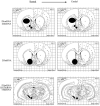Effects of chronic environmental and social stimuli during adolescence on mesolimbic dopaminergic circuitry markers
- PMID: 17590508
- PMCID: PMC2080836
- DOI: 10.1016/j.neulet.2007.04.088
Effects of chronic environmental and social stimuli during adolescence on mesolimbic dopaminergic circuitry markers
Abstract
Previously, we have shown that chronic exposure to environmental and social stimuli (ESS) during adolescence prevents the development of behavioral sensitization to amphetamine in adult rats. At the onset of the peripubertal-juvenile period (28-d) male rats were subjected to a 28-d long intermittent ESS protocol or handled as controls (NO-ESS). Twenty-four hours after the last session of ESS or NO-ESS, all rats started a regimen of behavioral sensitization to amphetamine (1mg/kg, i.p.), in which rats were injected every third day with amphetamine or saline on four occasions. Then following one week abstinence all rats were challenged with a lower dose of amphetamine (0.5mg/kg, i.p.) and their locomotor activity monitored for 2h. Our results showed that while NO-ESS rats developed behavioral sensitization to amphetamine, ESS rats did not develop this behavior. All rats were then sacrificed 3 days following the challenge to allow for amphetamine clearance. Since mesolimbic dopamine has been implicated in behavioral sensitization to amphetamine we compared messenger RNA (mRNA) expression of key dopamine-related molecules in the mesolimbic circuitry in ESS and NO-ESS rats. A decrease in dopaminergic D1 receptor (D1R) gene expression in the caudate-putamen (CPu) was associated with amphetamine sensitization in the controls, possibly as a result of a chronic increase in DA release. In contrast, amphetamine treatment did not modulate D1R mRNA levels in ESS rats. No change has been detected in any other dopaminergic markers [D2R, D3R, tyrosine hydroxylase (TH) or dopamine transporter (DAT) mRNAs]. Consequently, we conclude that ESS may inhibit the development of behavioral sensitization to amphetamine through preventing the decrease in CPu D1R mRNA levels.
Figures



Similar articles
-
Dopamine transporter, but not tyrosine hydroxylase, may be implicated in determining individual differences in behavioral sensitization to amphetamine.Physiol Behav. 2005 Oct 15;86(3):347-55. doi: 10.1016/j.physbeh.2005.08.005. Epub 2005 Aug 29. Physiol Behav. 2005. PMID: 16126238
-
Prenatal amphetamine exposure effects on dopaminergic receptors and transporter in postnatal rats.Neurochem Res. 2011 Oct;36(10):1740-9. doi: 10.1007/s11064-011-0489-z. Epub 2011 May 25. Neurochem Res. 2011. PMID: 21611835
-
Dysregulation of the mesolimbic dopamine system and reward in MCH-/- mice.Biol Psychiatry. 2008 Aug 1;64(3):184-91. doi: 10.1016/j.biopsych.2007.12.011. Epub 2008 Feb 20. Biol Psychiatry. 2008. PMID: 18281019
-
Cannabidiol Counteracts Amphetamine-Induced Neuronal and Behavioral Sensitization of the Mesolimbic Dopamine Pathway through a Novel mTOR/p70S6 Kinase Signaling Pathway.J Neurosci. 2016 May 4;36(18):5160-9. doi: 10.1523/JNEUROSCI.3387-15.2016. J Neurosci. 2016. PMID: 27147666 Free PMC article.
-
Maternal high fat diet during the perinatal period alters mesocorticolimbic dopamine in the adult rat offspring: reduction in the behavioral responses to repeated amphetamine administration.Psychopharmacology (Berl). 2008 Mar;197(1):83-94. doi: 10.1007/s00213-007-1008-4. Epub 2007 Nov 16. Psychopharmacology (Berl). 2008. PMID: 18004547
Cited by
-
Brief Social Isolation in the Adolescent Wistar-Kyoto Rat Model of Endogenous Depression Alters Corticosterone and Regional Monoamine Concentrations.Neurochem Res. 2017 May;42(5):1470-1477. doi: 10.1007/s11064-017-2203-2. Epub 2017 Feb 24. Neurochem Res. 2017. PMID: 28233145
-
Chronic variable physical stress during the peripubertal-juvenile period causes differential depressive and anxiogenic effects in the novelty-seeking phenotype: functional implications for hippocampal and amygdalar brain-derived neurotrophic factor and the mossy fibre plasticity.Neuroscience. 2011 Sep 29;192:334-44. doi: 10.1016/j.neuroscience.2011.06.077. Epub 2011 Jul 2. Neuroscience. 2011. PMID: 21767611 Free PMC article.
-
Stressful environmental and social stimulation in adolescence causes antidepressant-like effects associated with epigenetic induction of the hippocampal BDNF and mossy fibre sprouting in the novelty-seeking phenotype.Neurosci Lett. 2011 Aug 26;501(2):107-11. doi: 10.1016/j.neulet.2011.06.058. Epub 2011 Jul 8. Neurosci Lett. 2011. PMID: 21767606 Free PMC article.
References
-
- Ahmed SH, Stinus L, Le Moal M, Cador M. Social deprivation enhances the vulnerability of male Wistar rats to stressor- and amphetamine-induced behavioral sensitization. Psychopharmacology (Berl) 1995;117:116–24. - PubMed
-
- Bardo MT, Bowling SL, Rowlett JK, Manderscheid P, Buxton ST, Dwoskin LP. Environmental enrichment attenuates locomotor sensitization, but not in vitro dopamine release, induced by amphetamine. Pharmacol Biochem Behav. 1995;51:397–405. - PubMed
-
- Bardo MT, Klebaur JE, Valone JM, Deaton C. Environmental enrichment decreases intravenous self-administration of amphetamine in female and male rats. Psychopharmacology (Berl) 2001;155:278–84. - PubMed
-
- Biron D, Dauphin C, Di Paolo T. Effects of adrenalectomy and glucocorticoids on rat brain dopamine receptors. Neuroendocrinology. 1992;55:468–76. - PubMed
-
- Burgdorf J, Panksepp J. Tickling induces reward in adolescent rats. Physiol Behav. 2001;72:167–73. - PubMed
MeSH terms
Substances
Grants and funding
LinkOut - more resources
Full Text Sources

